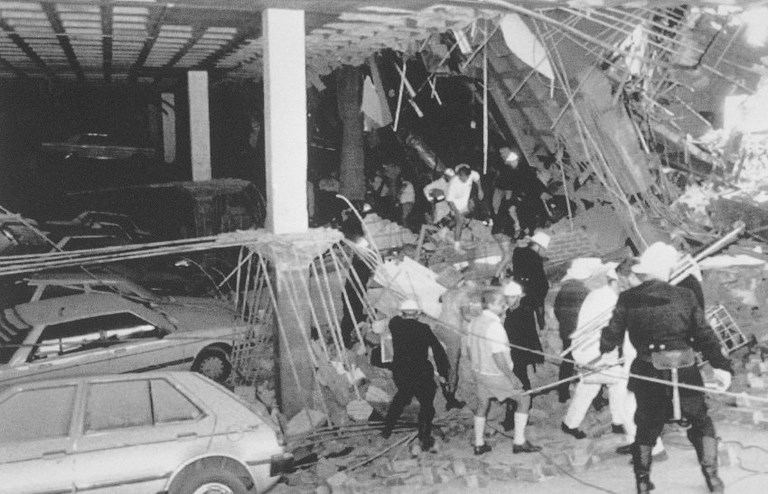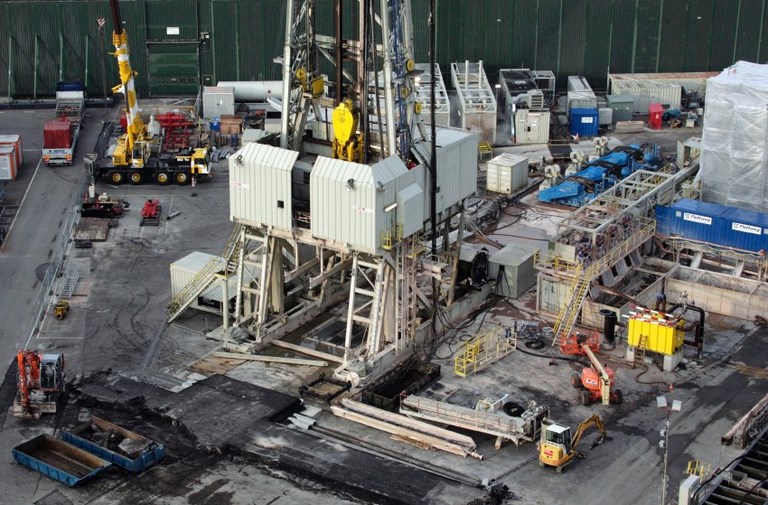Man-made earthquakes
Concealed Origins of Catastrophes
The deadly earthquakes which occurred in Spain in 2011 were triggered by human activity, scientists say. This is not the only time that this happened: new data shows that man bears responsibility for many catastrophic earthquakes...
Evidently, geophysicist Christian Klose was not a very a welcome guest in Australian Newcastle. His lecture had not been advertised, his speech had been limited to 45 minutes - and afterwards, there was hardly any discussion, Klose reports. The mood in the auditorium was not really cordial.
To the German scientist from the US American research institute Think Geohazards, this reticence came as no great surprise, for what he was reporting was quite unheard of: the devastating earthquake which had occured in Newcastle in December 1989, in which 13 people died, 160 were injured and tens of thousands of buildings had been damaged, had been triggered by mining activity, Klose had discovered.
Representatives of the mining company were appalled, they declined responsibility, according to them, the earthquake had natural origins. And the geological administration of Australia as well as the local researchers held back, for they generally cultivate close relations with the mining industry. Concern over compensations was in all minds: the earthquake had caused damages estimated at 3.5 billion US dollars. "The costs there were higher than all the combined earnings since the mine opened in 1799," Klose says.
Meanwhile, Klose stands no longer alone with his theory; among many scientists, the Newcastle earthquake is considered to have been humanly caused. The extraction of 500 million tons of coal has dangerously disburdened the underground, enabling it to set itself into motion, Klose calculated. As ever greater loads went missing, it appears that a rock seam of a length of about one kilometer came increasingly under strain.
By December 1989, the pressure had risen by around 0.1 atmosphere - a dangerous threshold value was reached, earthquakes became possible at any time: already an increase in pressure in the upper Earth crust such as this one, of one tenth of the normal air pressure, can bring the ground to move along underground seams of rock.

Eartquake in Newcastle, Australia, 1989
In other places too, man subjects the ground to dangerous stresses, for instance through the extraction of gas, through drilling for oil and gas, with the installation of geothermal energy facilities or through building dams. All over the world, there have occurred at least 200 strong earthquakes which have been triggered by human activity, Klose reports in the scientific His study corroborates our own investigations, says geophysicist Frank Schilling of the Karlsruher Institut für Technology (KIT).
The most severe quakes caused by human activity are, according to Klose's study, the following:
* Zipingpu-Dam in China 2008: quake intensity 7.9; 80,000 dead.
* Natural gas field of Gazli in Uzbekistan 1984: quake intensity 7.2; 85 million dollar damages (estimated value at the time). Two more severe quakes occurred there - but the extent of damage was kept secret under the Soviet regime.
* Hebgen-Dam in the USA 1959: quake intensity 7.1; several dozen dead in Yellowstone-Nationalpark, 74 million dollar damage (estimated at today's value).
* Coalinga-oilfield in the USA 1983: quake intensity 6.5; dozens of injured, ten million dollar damages (value at the time).
* Koyna-Dam in India, 1962: quake intensity 6.3; 200 dead, immense damage (no precise data).
Another catastrophe must now be added to the list: scientists have reported that the earthquake in Lorca in the South of Spain in 2011 was also triggered by human activity. Something similar happened there to what happened in Australia in 1989: in Spain too, the underground was destabilized through exploitation, seismologists around Pablo Gonzàlez at the University of Western Ontario in Canada report in the scientific magazine Nature Geoscience.
While in Australia it was coal that had been extracted, in Spain it was phreatic water. By 1960, the level had already fallen by over 250 m. According to the study, a seam in the underground became so much disloaded that it finally lost its hold and broke.
Besides calculations, scientists base themselves on radar images which document the way the soil warped during the quake: maps show that the broken aereas were situated precisely where the ground had been most unburdened through the extraction of water - the buffer had so to speak gone missing, which was protecting against stress movements in the underground.
Still scientists trying to establish the man-made origin of earthquakes encounter a decisive problem: "there is no such thing as a last proof,' Klose admits. It can never be totally excluded that a quake was not in the end natural.
And so the debate ends mostly in a defensive stance of the responsible administrations and companies. The exemplum horribilis appears to be the quake at the Koyna-Dam in India in December 1967, in which 200 people died. Only decades later was it admitted that the water masses of the then newly filled-up Koyna-Dam had triggered the quakes.
Objects of dispute are, for instance, the following cases:
The heavy quake in the South of China on May 12th, 2008 in which 80,000 people died and hundreds of thousands were seriously injured, had been triggered by an artificial dam, Klose and other seismologists have calculated. The engineers had ignored the fact that a stress-laden rockseam ran through the underground in the vicinity. The water masses rested with a weight of 320 million tons onto the fragile underground. The pressure in the underground had risen to 25 times above normal, Klose calculated. Chinese scientists published counter-studies and the authorities are still denying a relationship between the catastrophe and the dam.
In March 1989, the collapse of a potash mine triggered an earthquake of 5.6 intensity in Thuringia (Germany). In the locality of Völkershausen many buildings had to be demolished. The underground cleanup engulfed according to insiders over 200 million euros. A political controversy followed: both German states, at the time, faulted each other. The West German Federal Republic blamed collapsed buttresses on the East German side; Erich Honecker, head of the East German Democratic Republic, faulted the quake on the large amount of liquids which had been squeezed into the ground on the Western side in order to extract the potash. At the end of the 1990s, geologists planned to discuss the matter in a specialist meeting - but it was removed in short order from the agenda.
For years, inhabitants in the vicinity of Saarlouis in the Saar have been protesting against light earthquakes which are regularly triggered by the mining activities in their region. The strongest recent quake occurred in February 2008. The quake of a 4 intensity damaged numerous buildings, people ran outside in fright. There are still disputes over compensation payments.
Until December 2006, Geopower Basel AG squeezed water through a 5 kilometer deep drilling hole into the rocky underground. It was supposed to spring back, heated by the heat of the earth, in order to drive steam turbines. But then there occurred a number of small jolts in the ground - the water pressure had created such a strong pressure underground that rock layers had exploded with a boom. There was no great damage, but the risk of further quakes seemed important enough. The Geopower company minimized matters to begin with, but then authorities stepped in to put an end to the project.

Basel Geopower AG drilling installation
Never before had such a thing happened in Hamburg: on October 20th, 2004 around 08:59 the buildings in the center shook, lamps started swinging, stucco fell from the walls. Yet Northern Germany is supposedly earthquake free. In Lower Saxony, halfway between Hamburg and Bremen, a light earthquake of 4.5 intensity had occurred - right in the middle of a gas extraction area. The culprits were rapidly identified: very ancient weak zones in the rock at great depth had fractured. Yet after an analysis through the newest methods, seismologists arrived at a far more sensitive result: according to them, it was the gas extraction which was responsible for the quakes - yet companies and authorities disagreed up front. Meanwhile, surveillance of the region with new earthquake sensors has been improved. In France and Italy strong earthquakes have occured in areas of gas extraction several times already.
Yet strong earthquakes must be expected foremost when very large amounts of material are shifted underground, geophysicist Schilling says. In small projects, such as geothermal drills, areas already burdened with hazards from previous earthquakes are especially at risk - the squeezed-in water could move already existing cracks.
Klose's analysis confirmed this; the strength of man-made earthquakes ist mostly dependent, according to his calculations, of the size of the masses shifted through human activity - independently from other geological structures in the upper Earth's crust. The risks from small gasfields such as in Germany, and from geothermic facilities would appear therefore distinctly limited. But great prudence is mandatory when man intervenes with large projects in areas which are actually earthquake-free: there, buildings are not earthquake proof.
These findings might well bring into disrepute a plan through which scientists intend to decrease climatic warming. According to this plan, the greenhouse gas carbon dioxyd (CO2) captured from the atmosphere would be pumped back into the ground in large quantities. Yet the pressure in a CO2 storage would necessarily be sujected to increase. If, according to this plan, some 30.000 tons of CO2 were to be squeezed into the rock in a great number of places, the same mass would end up accumulating after 30 years as in the case of the infamous Zipingpu Dam in South China in 2008, warns Klose. Quakes would become likely, corroborate scientists around Mark Zoback of the United States Geological Survey.
See USGS report: Earthquake triggering and large-scale geological storage of carbon dioxide
Concerns are being raised, for instance, by a geothermal project near Los Angeles in California. 400 million tons of water were removed from the Salton Lake in the 1980s, which is equivalent to the weight of some 60 times the Pyramid of Cheops. Now scientists of the USGS speculate that this could bring the San Andreas Fault to move: the famous earthquake fault runs right under Salton Lake. In the mean time, the number of quakes in the area has doubled. Could the fault rupture in one heavy blow?
As for the Australians, they keep their cool and carry on, from all appearances. The ground meanwhile has become restive around mining areas in the West of the country as well; there occurred even a quake of intensity 5 in an otherwise still region. But the extraction of natural resources proceeds unperturbed.
Links
This article by Christian Klose, Journal of Seismology,January 2013, Volume 17, Issue 1, pp 109-135, can be purchased online:
This article from Nature Geoscience 5, 821–825 (2012) doi:10.1038/ngeo1610, Published online 21 October2012, can be purchased online:
Abstract: The 2011 Lorca earthquake slip distribution controlled by groundwater crustal unloading

